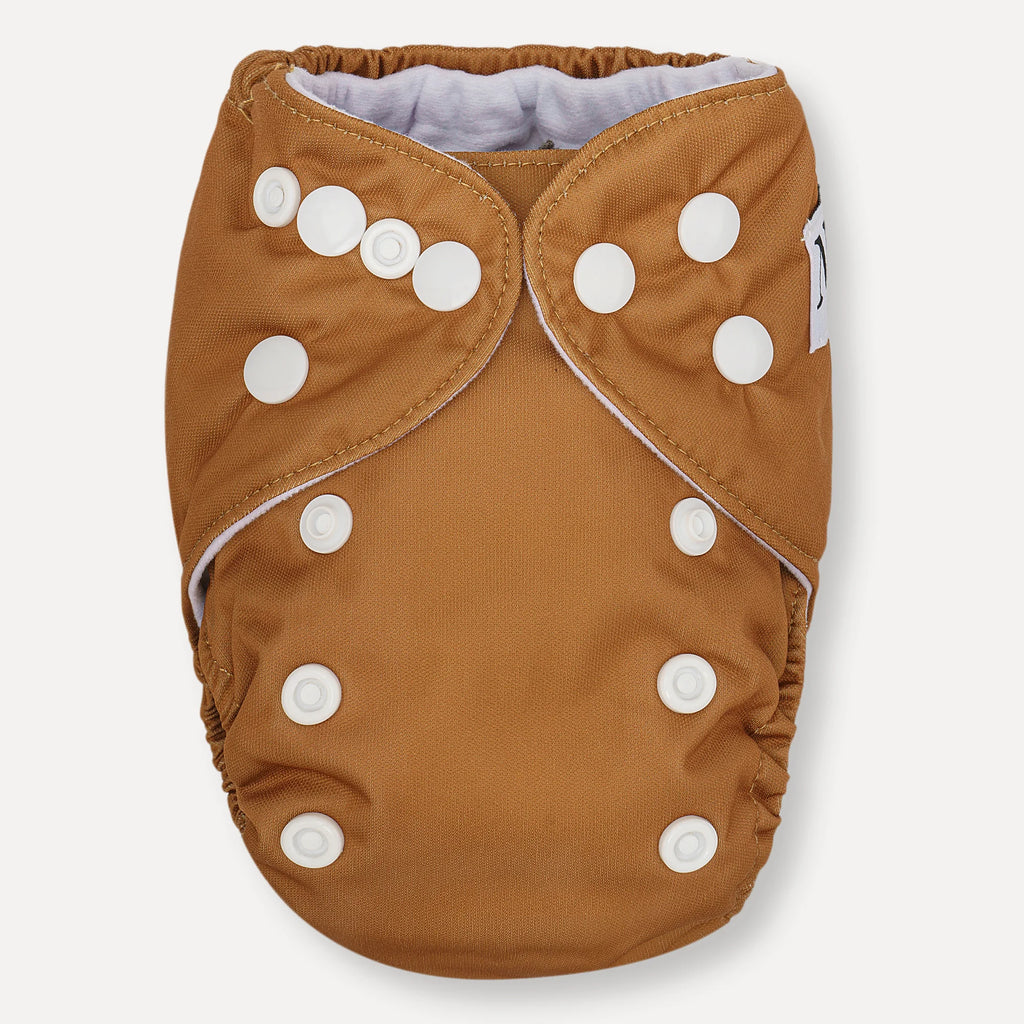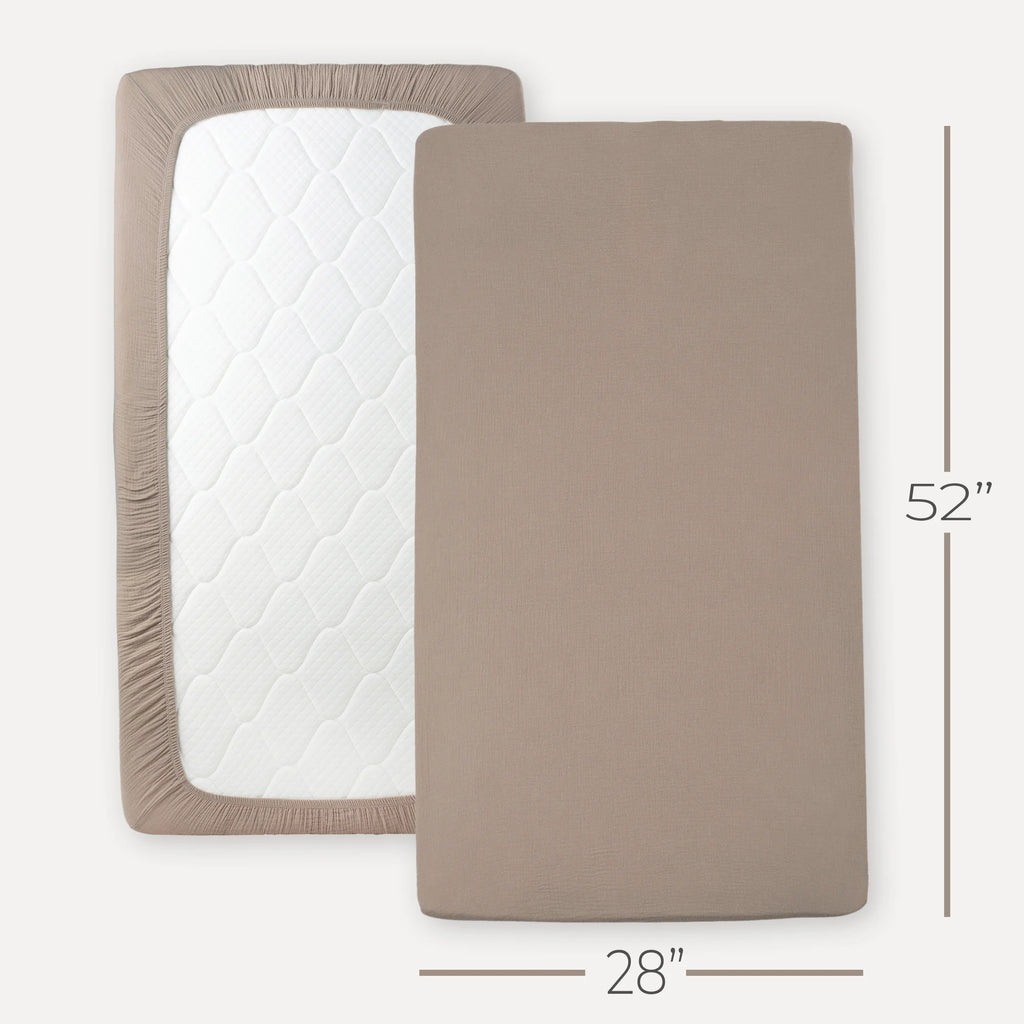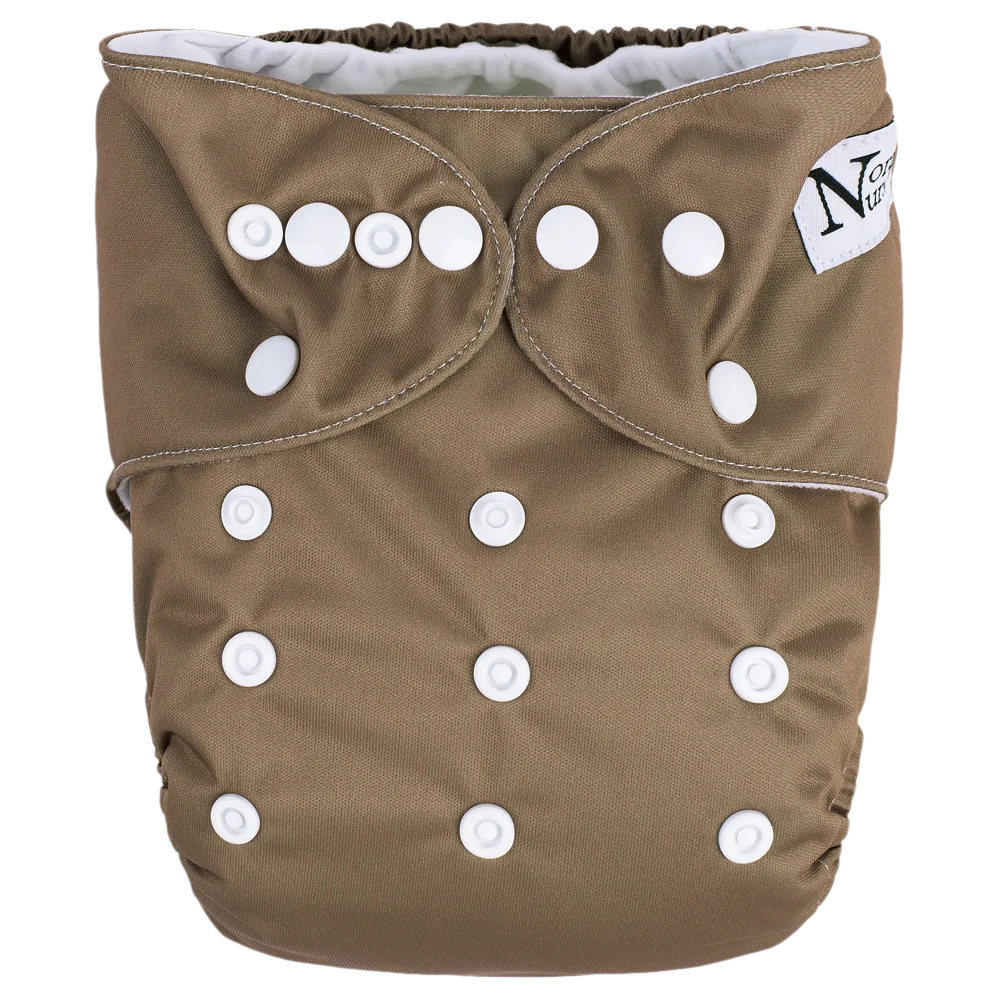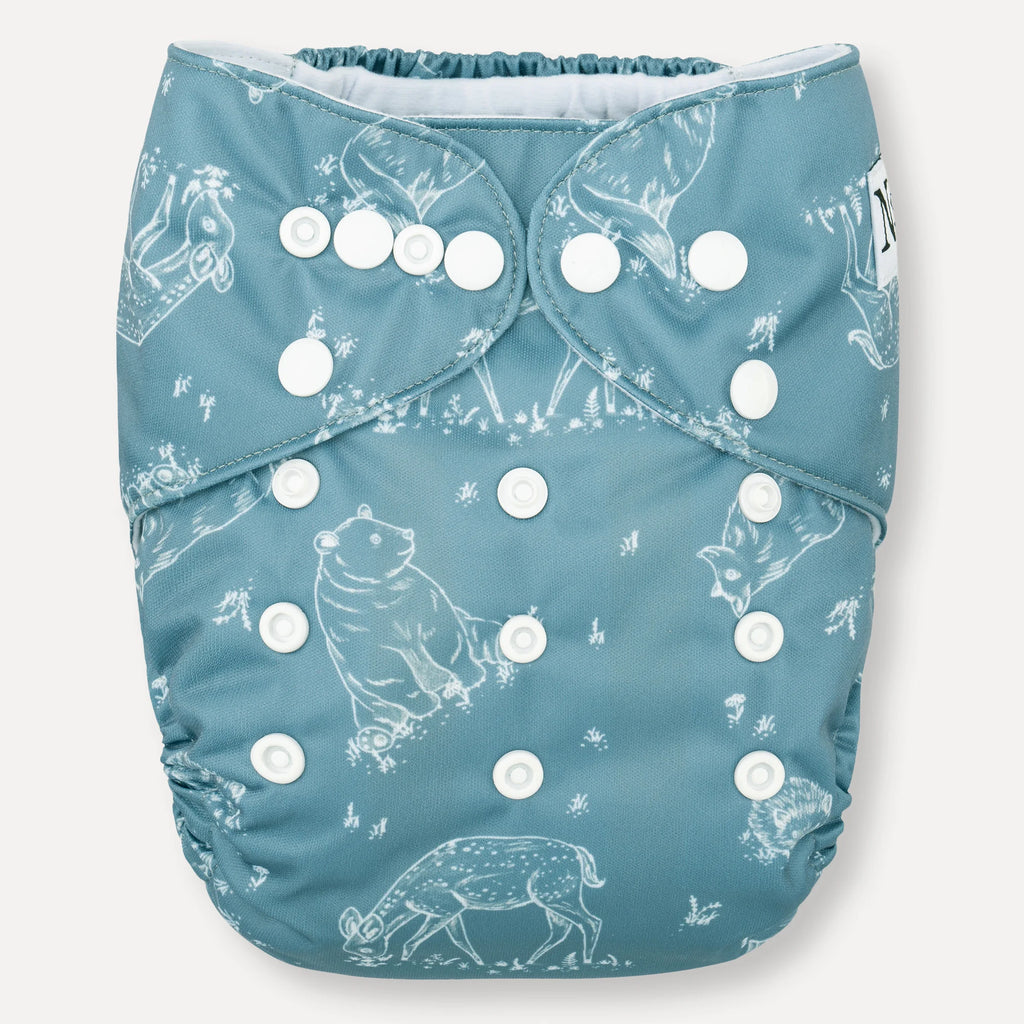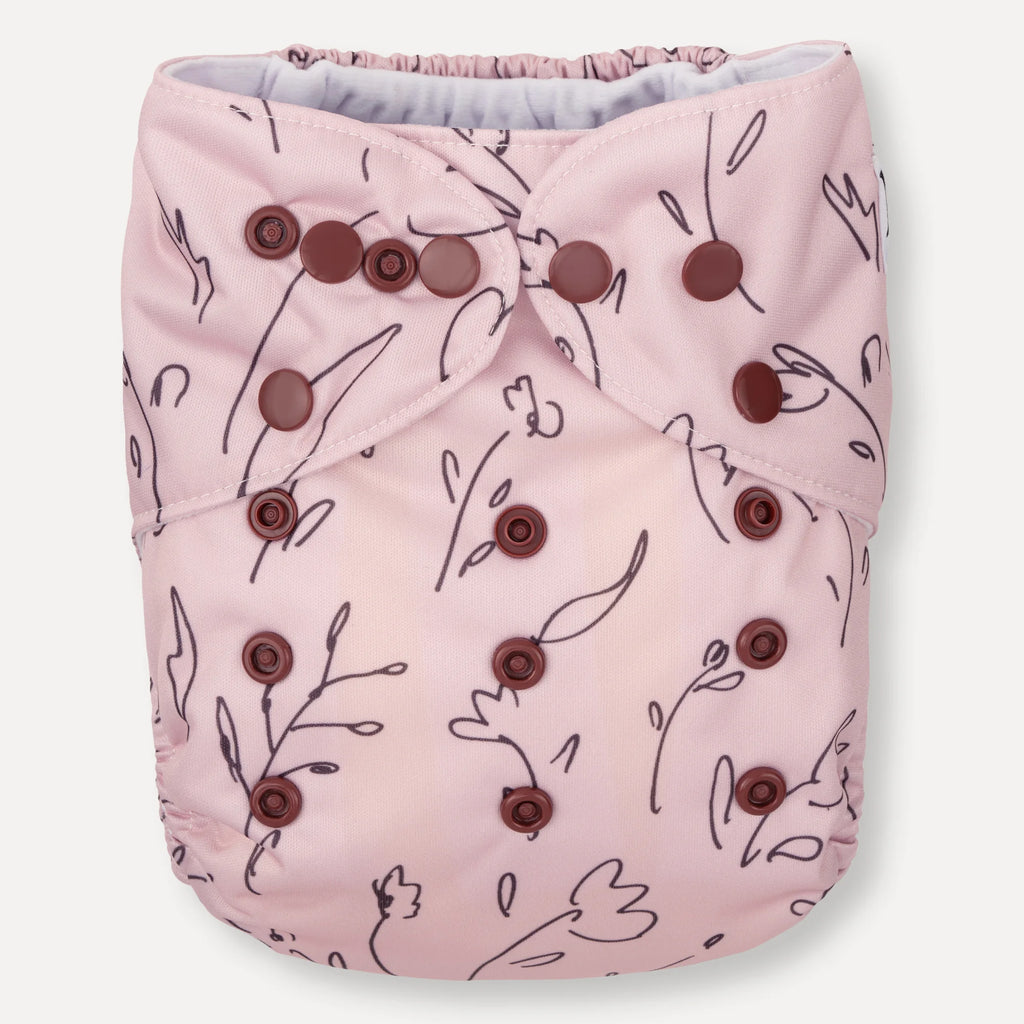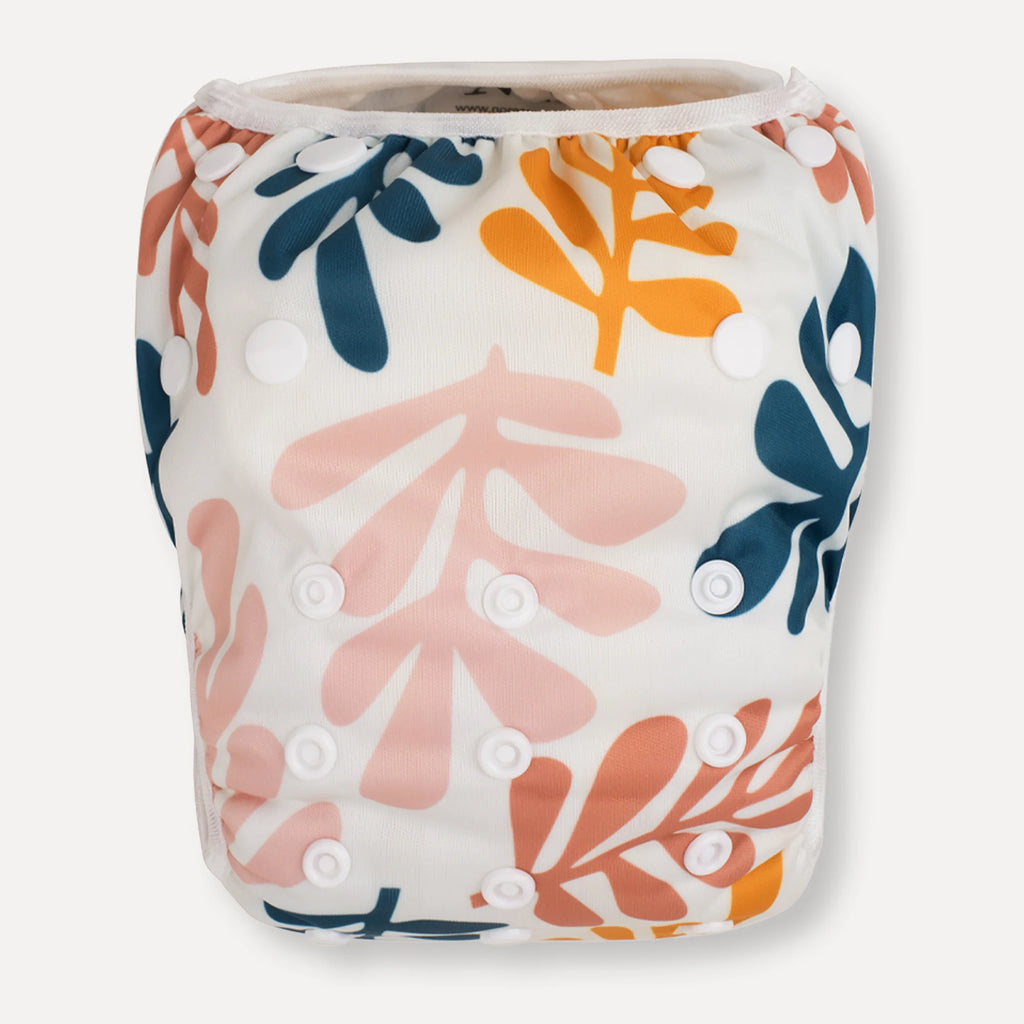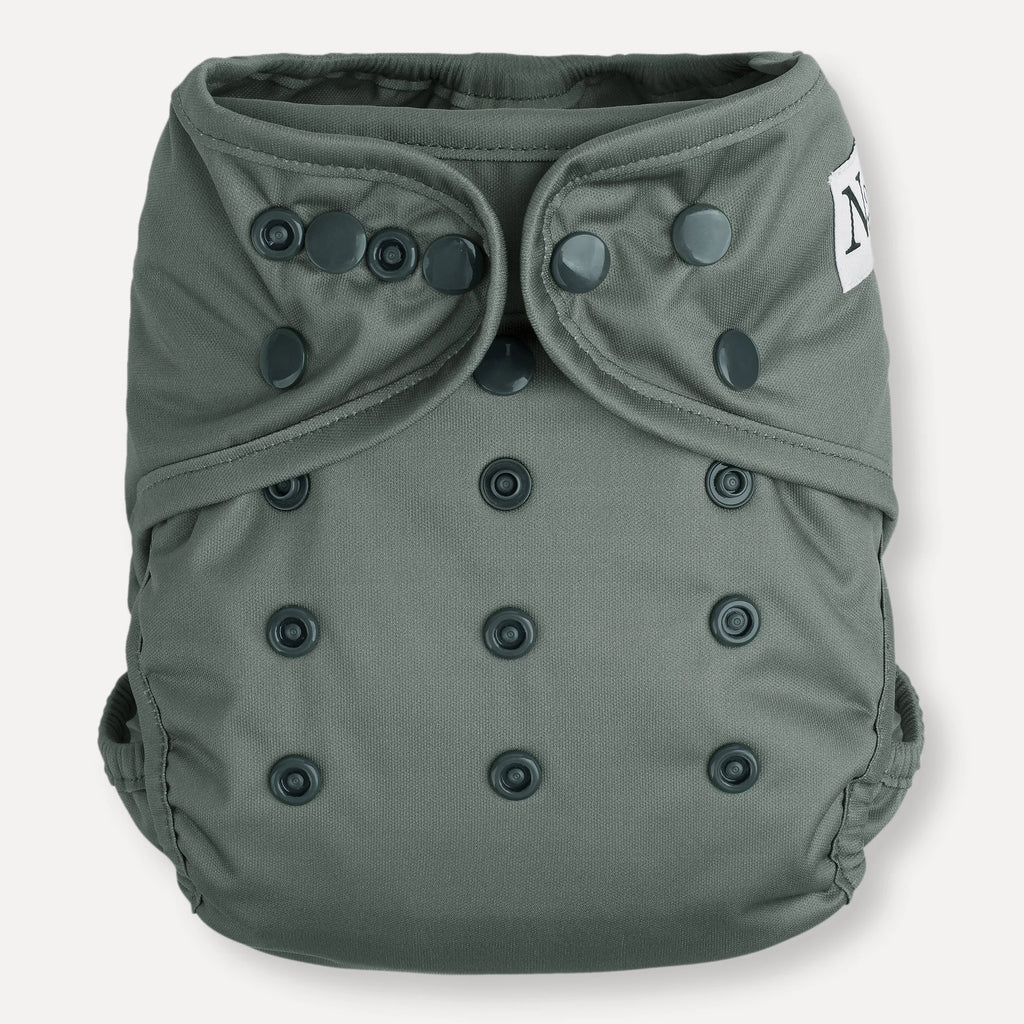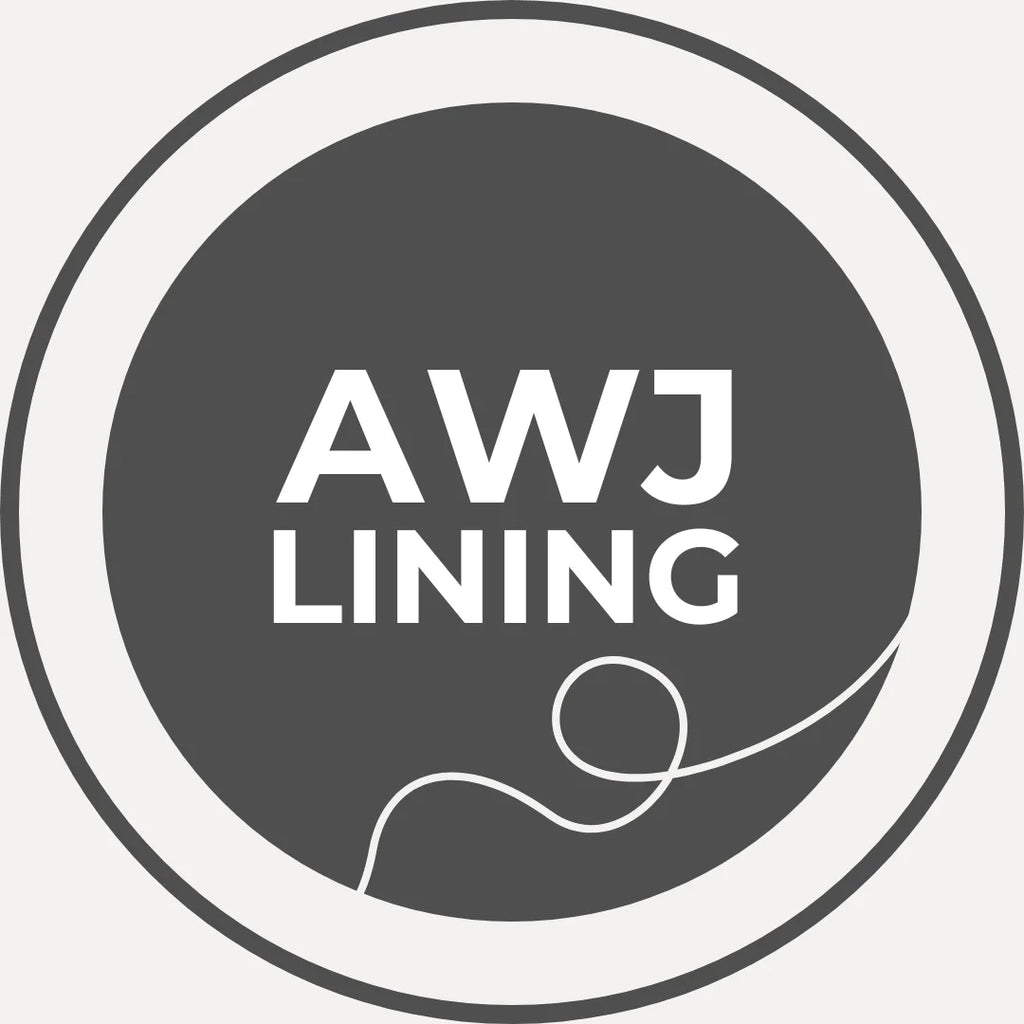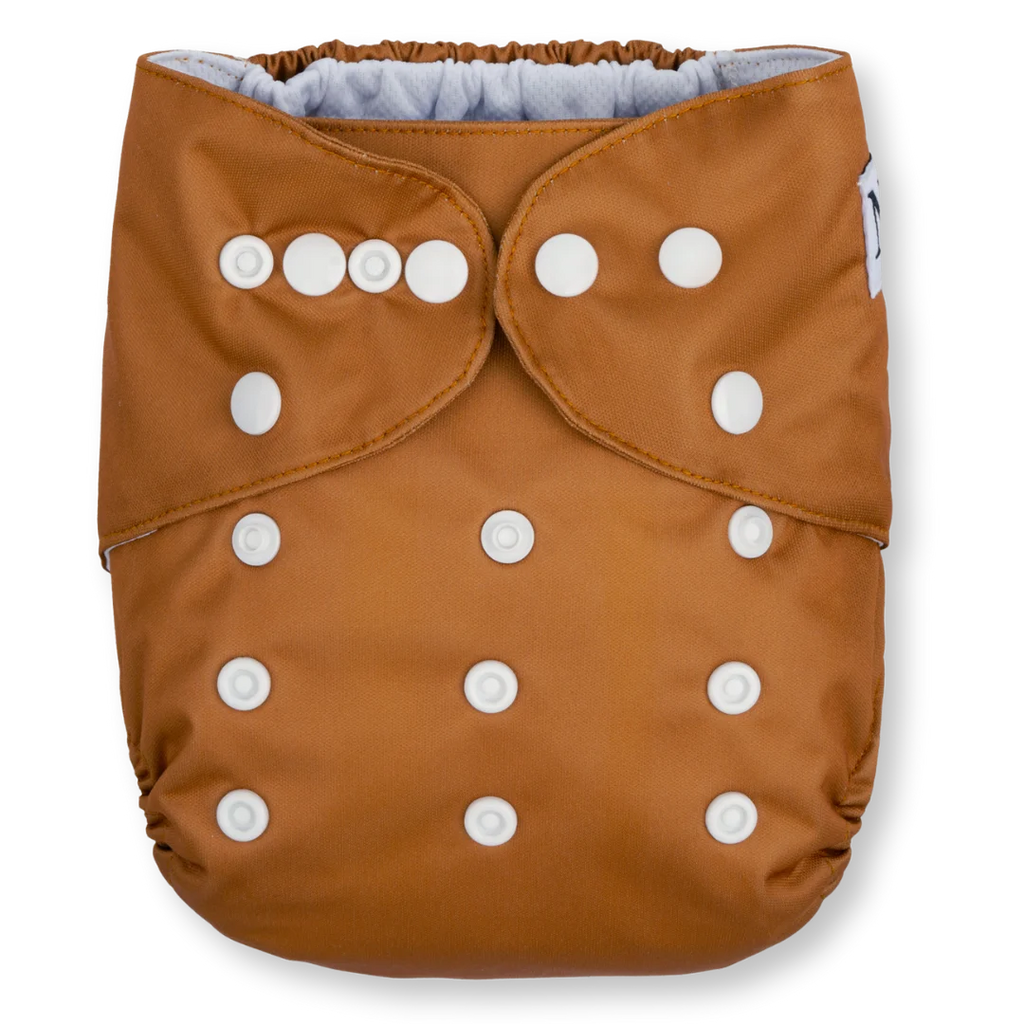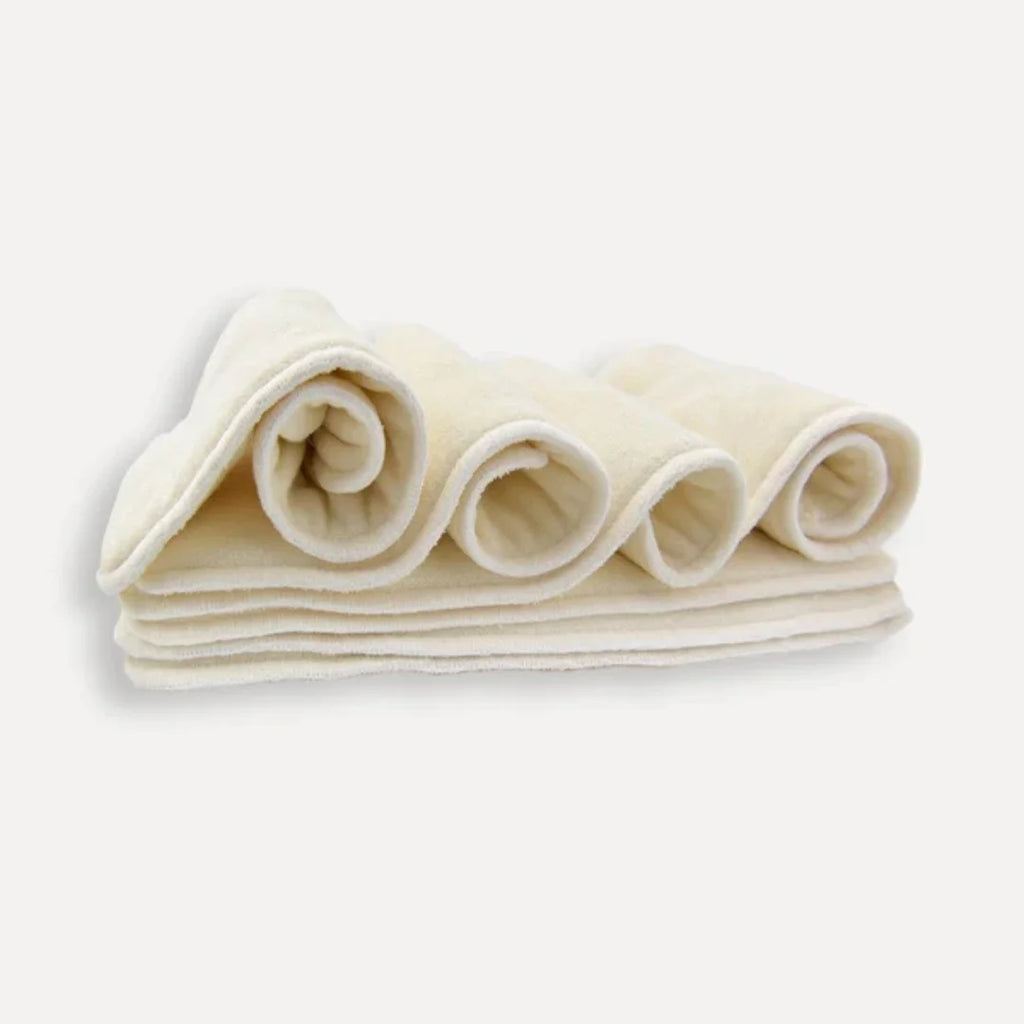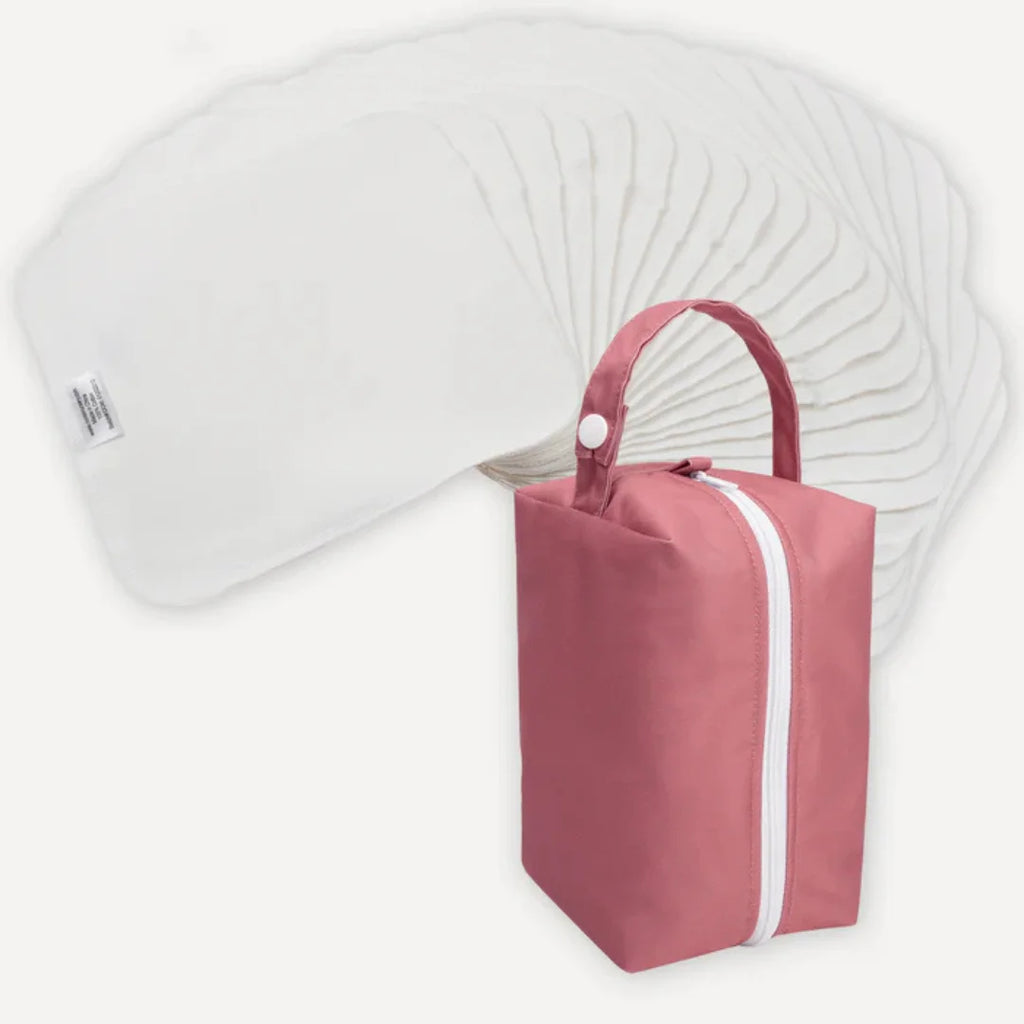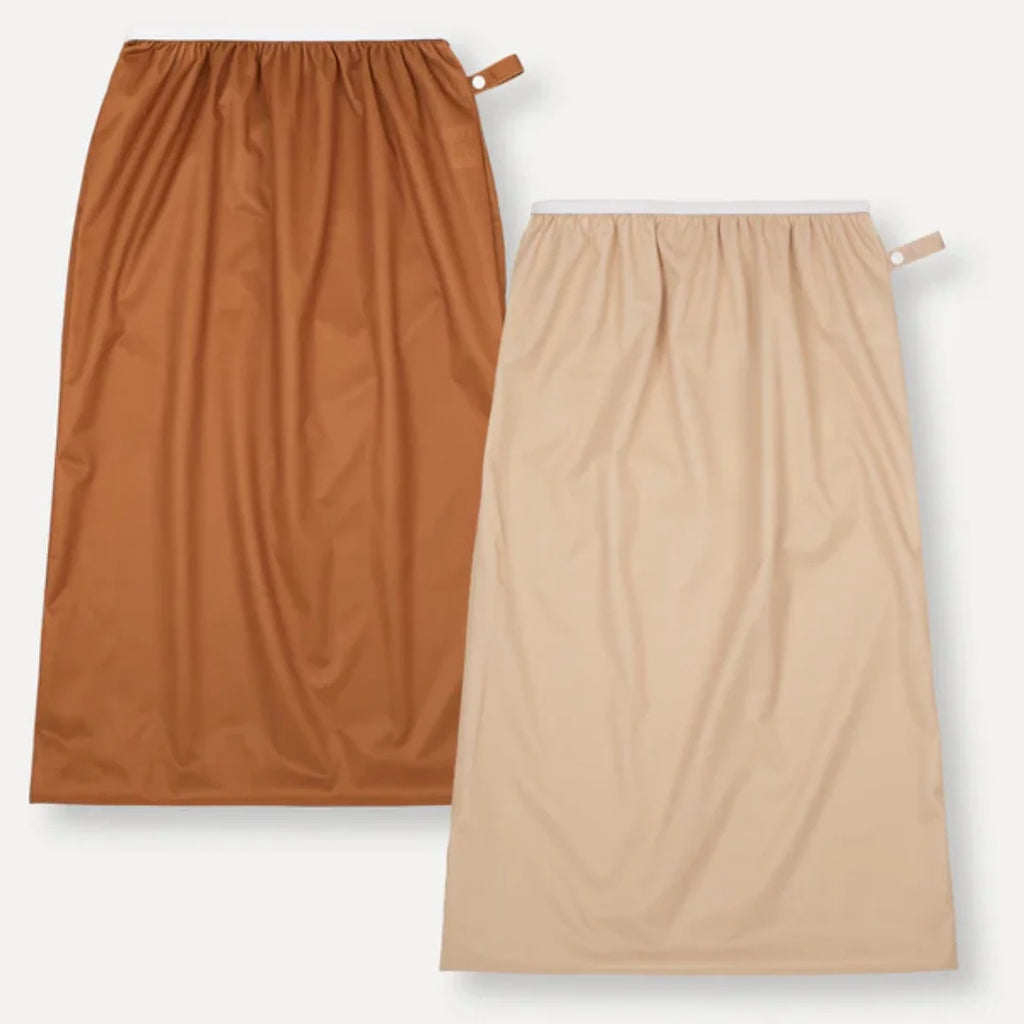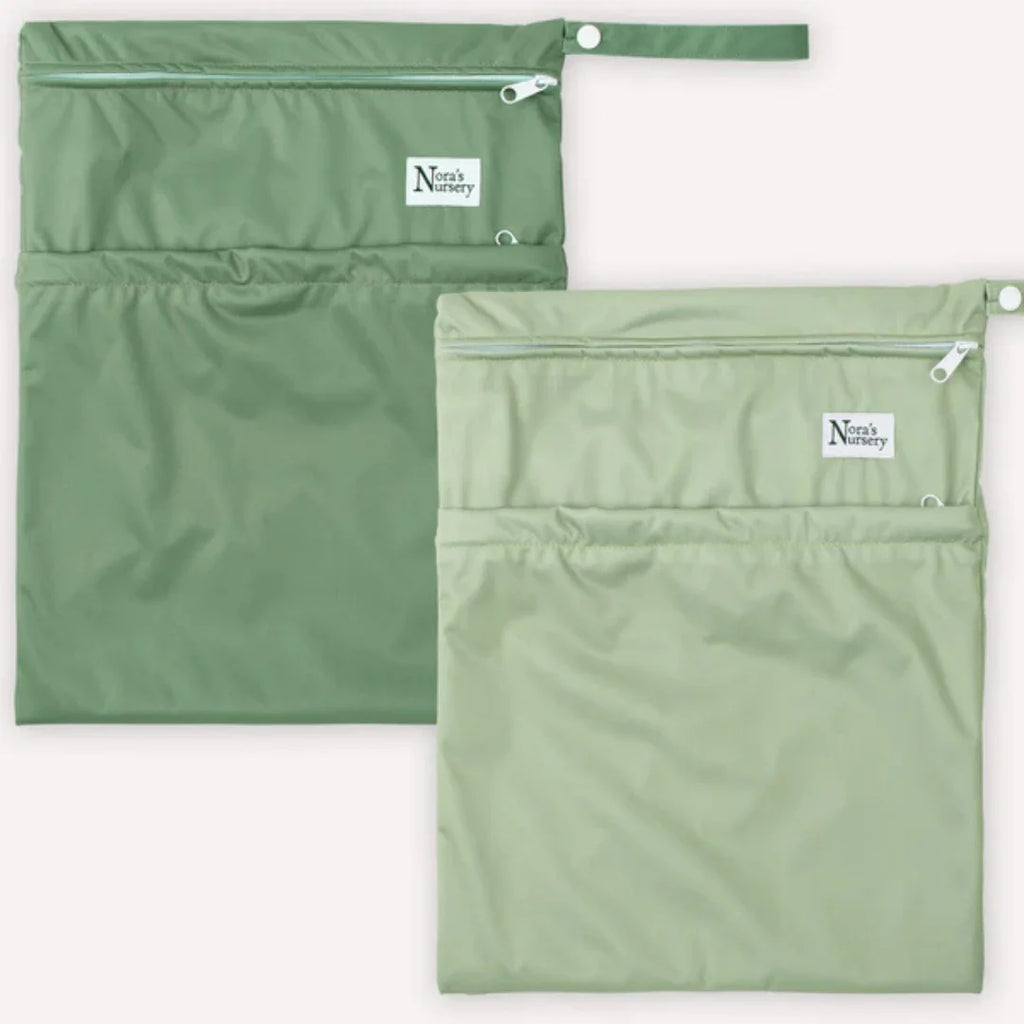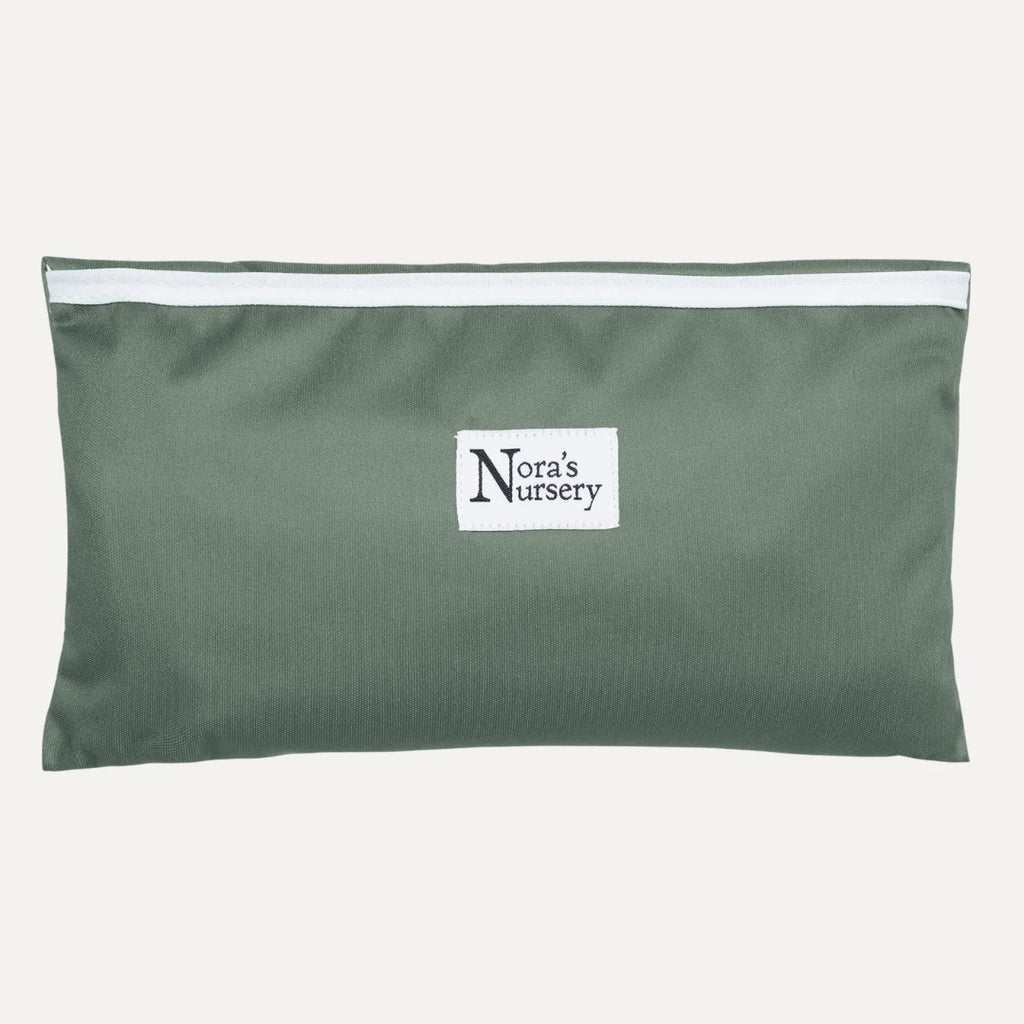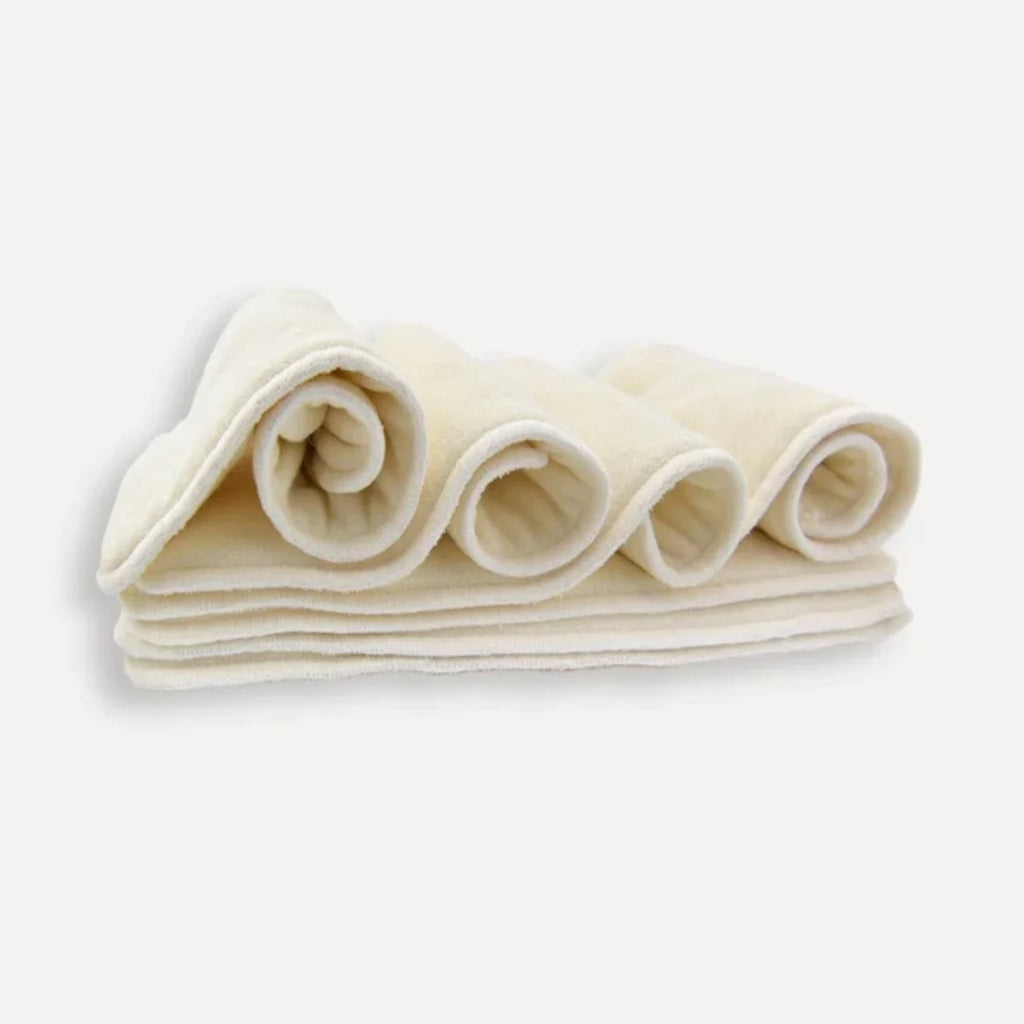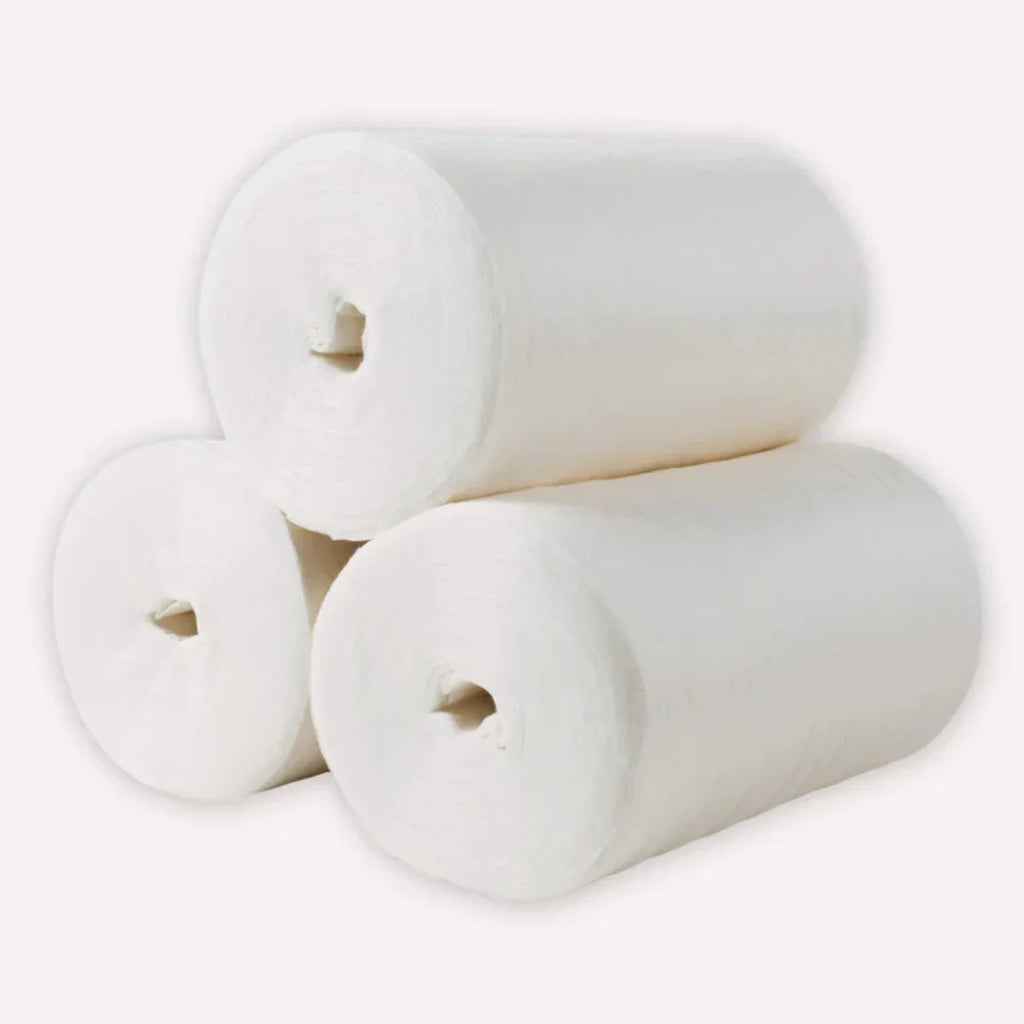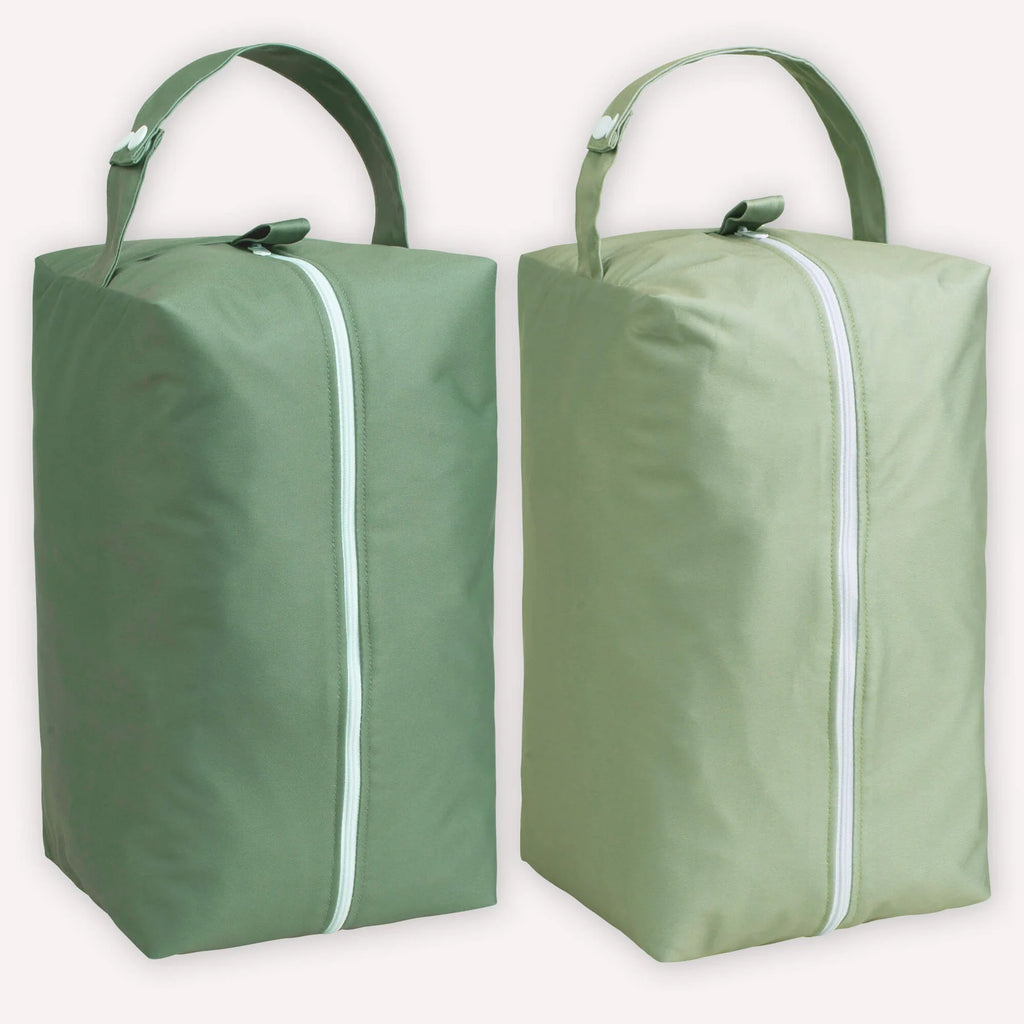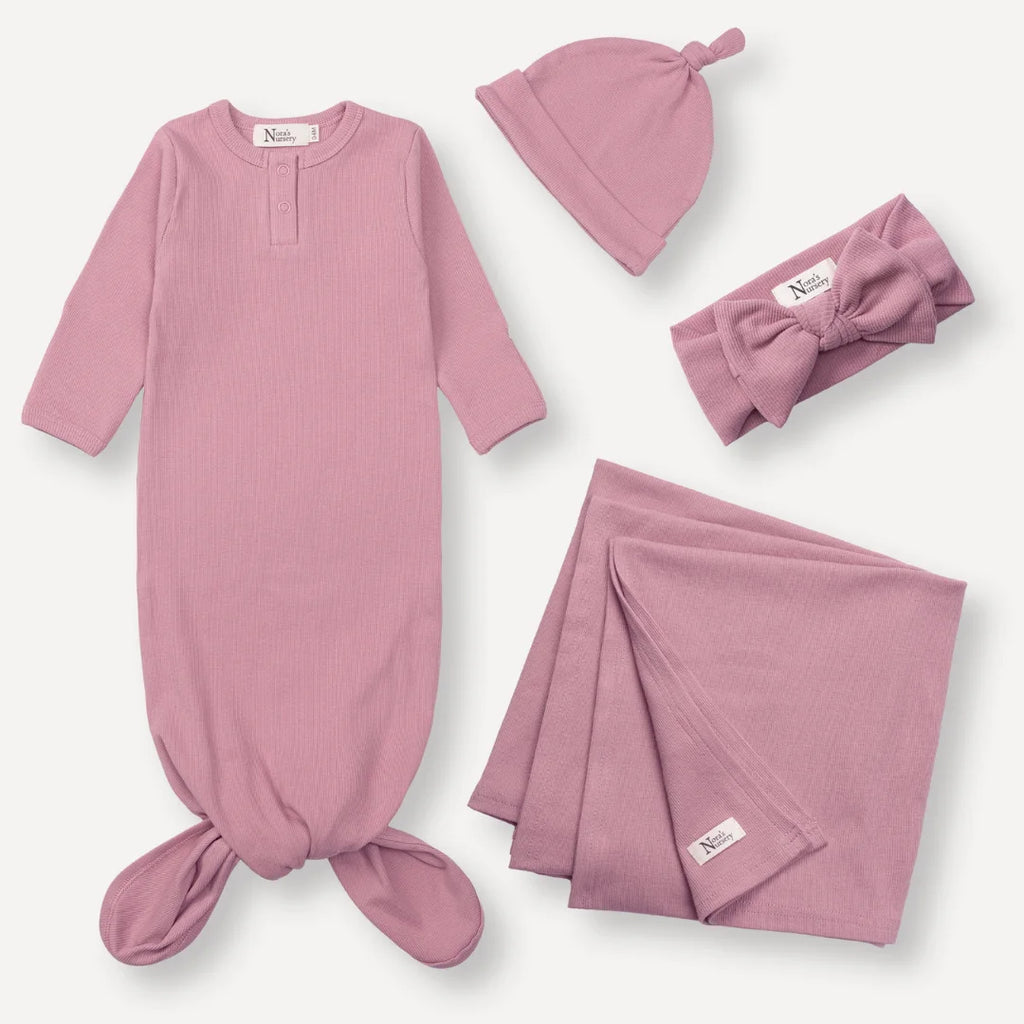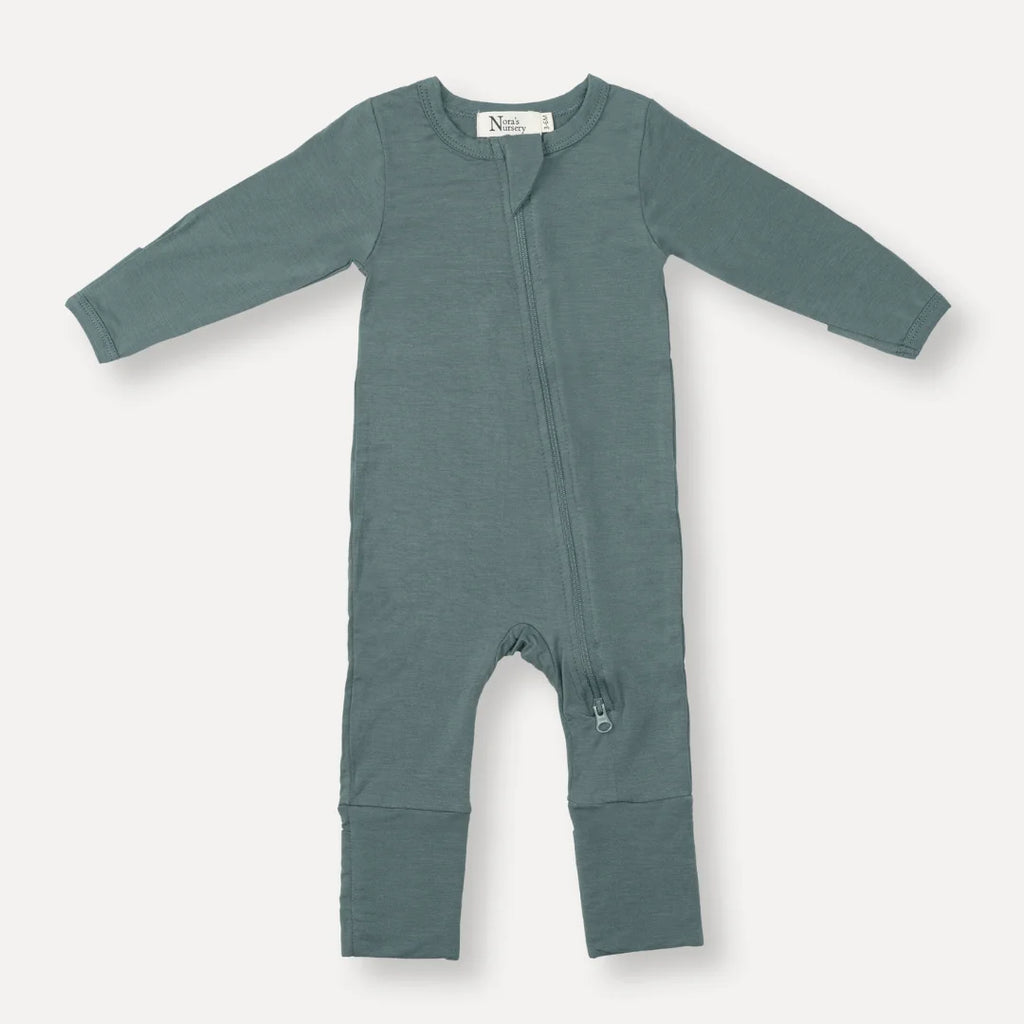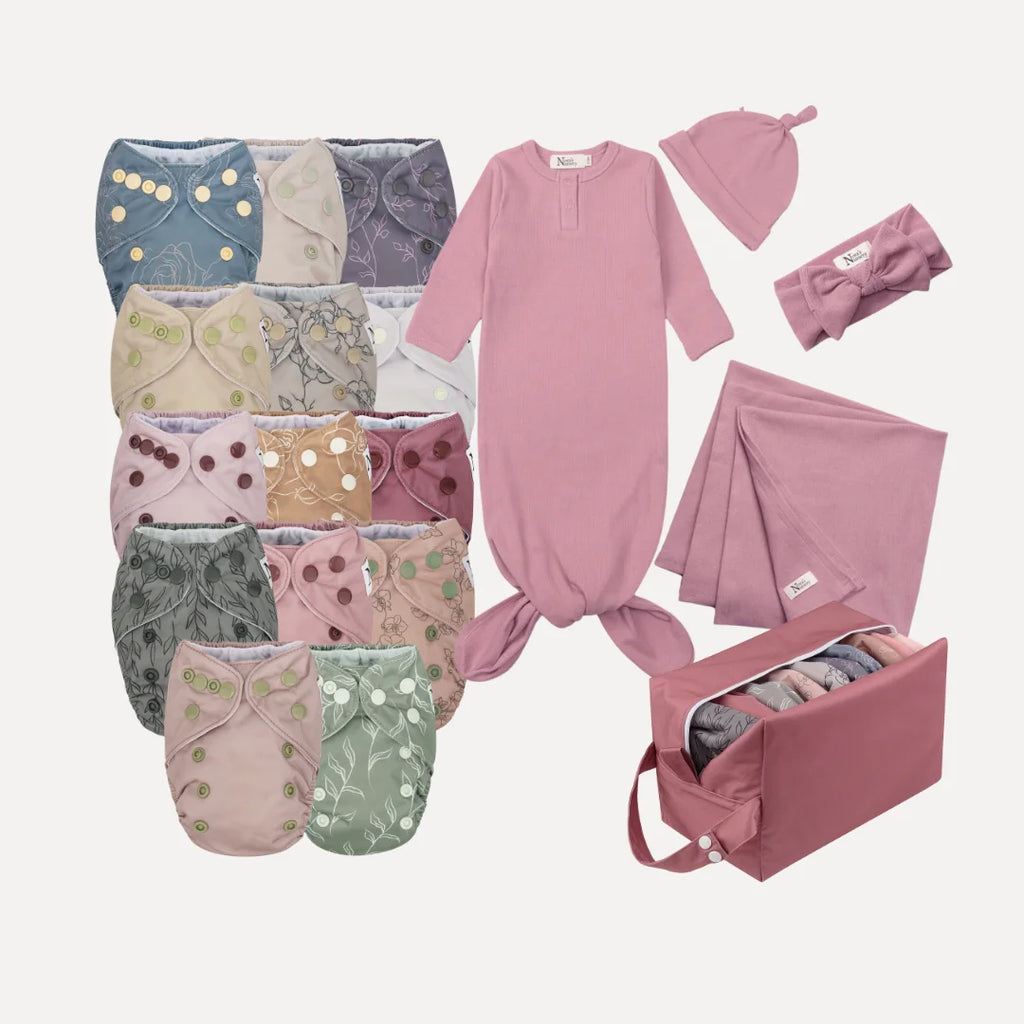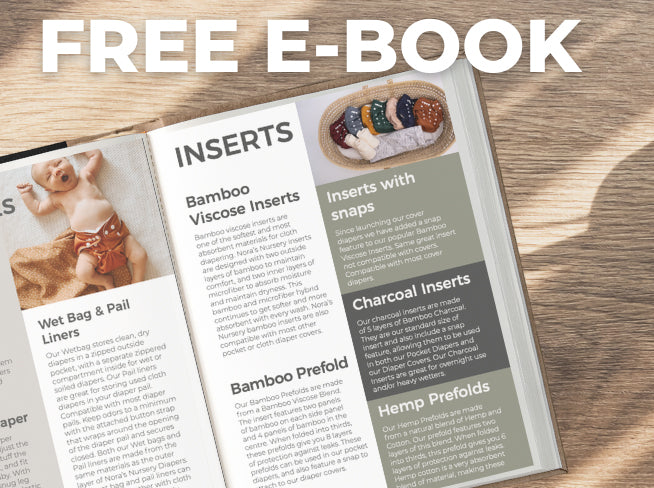Finding the right cloth diaper fit is important if you want to ensure your baby stays comfortable while avoiding leaks. Below are step-by-step guides to help you size your Nora's Baby Pocket Diapers, and Diaper Covers, Newborn All In One Diapers, and Toddler Size Pocket Diapers.

If you are left wondering, why do my cloth diapers leak? We can help you pinpoint the reasons behind cloth diaper leaking, and provide simple and effective solutions. Even using a cloth diaper overnight is possible. To prevent your baby diaper leaking overnight, we recommend adding extra inserts for overnight periods to keep baby comfortable.
Get To Know Our Sizes!
Here at Nora's, we know the importance of finding the right fit. Finding the right fit is the first step to leak-free, comfy cloth diapering—and we’ve got options for every stage of your baby’s journey!
Toddler Size Pocket Diapers: Our Toddler Pocket Diapers are designed to grow with your baby, from about 35 pounds to 55 pounds. One set of toddler diapers, if properly cared for, should last you until potty training! These diapers are designed with a wide range of sizes to ensure the perfect cloth diaper fit for your toddler. Larger Inserts for Toddler Size Pocket Diapers sold separately.
Fit Tips
A good fit = happy baby and fewer leaks! In order to avoid cloth diaper leaks, ensure you get the proper fit. Follow our easy photo sizing guide (below) to make sure you're getting the best possible fit for your little one at any stage.
Getting started - become familiar with your cloth diaper snaps
The perfect cloth diaper fit depends on getting the snaps just right for your baby’s size and level of activity. So to start off, let’s get to know the diaper snaps.
Baby Size Pocket Diapers and Diaper Covers
The top row of snaps are the waist snaps. There are a total of ten snaps across the front of the diaper, and two snaps on the inside of the flaps that fold around the front of the diaper. These will adjust the fit around your baby’s waist.
The second row of snaps are the thigh snaps. There are four snaps on each side of the diaper, and one snap on the inside of the folding flaps. These will adjust the fit around your baby’s thighs, and are important to get right in order to avoid leaks.
The rise snaps are the three rows and three columns of snaps across the front and middle of the diaper. Adjust the rise snaps based on your baby’s length and level of activity, from newborn to crawler to walker.
Step by Step Guide to the Perfect Cloth Diaper Fit

Getting the right fit – how to adjust your diaper length
Start with fitting for your baby’s length. Length is adjusted by the snaps that run up and down the front of the diaper. There are three rows and three columns of snaps which adjust the rise or height of the diaper. For small babies and newborns, you will likely connect the bottom three snaps with the top three snaps. For crawlers, you will likely connect the middle three snaps with the top three snaps. And for toddlers and taller babies, you will leave all the snaps undone, leaving the diaper at its longest length. Check out our Toddler Size Pocket Diapers when transitioning to the next size up!
Sizing Your Diaper Length for Baby’s Age and Level of Activity
![]()
Newborn – Smallest Setting

Crawler - Medium Setting
Attach the top row of the rise snaps to the middle row of the rise snaps.

Walker - Largest Setting
Leave the rise snaps fully open.

A good fit will have the diaper aligned right at the hip bones, under the bellow button.
TIP: Leave the insert aside for this stage, as it is very difficult to effectively adjust the rise of the diaper with the insert enclosed.
Once you have the appropriate rise for your baby, slip in the insert. Now you’re ready to place the diaper onto your baby!
Getting the right fit – how to adjust your diaper width
The top two rows across the diaper adjusts the diaper width.
Start by adjusting the snaps around baby’s thighs. These are the snaps across the second row from the top of the diaper. There are four snaps on each side of the diaper, and one snap on the inside of the front flap that folds over and secures the diaper. You want to make sure to get this fit just right in order to prevent cloth diaper leaks. Cloth diaper leaking generally happens around the thighs when diapers are too loose.
Once you have the right fit around the thigh, adjust the fit around the waist. Using the top row of snaps, secure the diaper snuggly around baby’s waist, just below the belly button. Use the double snaps along the top row to secure the diaper.
TIP: on the inside of the diaper, there are 3 snaps on the front flap that folds over the diaper. Ensure all three are snapped in place for the best fit.
Have I got the right cloth diaper fit?
Fitting your baby can take some trial and error. The sizing will continue to change as your baby grows and becomes more active. Ensure the fit is tight enough to hold in moisture and solids. For baby’s comfort, ensure that you can comfortably stick one finger between baby’s legs and the diaper. Also ensure you can fit no more than two fingers between the front of the diaper and baby’s belly. Slight indents on your baby’s skin are normal so long as you pass the finger test!


The top row of snaps are the waist snaps. There are a total of eight snaps across the front of the diaper, and two snaps on the inside of the flaps that fold around the front of the diaper. These will adjust the fit around your baby’s waist.
The second row of snaps are the thigh snaps. There are three snaps on each side of the diaper, and one snap on the inside of the folding flaps. These will adjust the fit around your baby’s thighs, and are important to get right in order to avoid leaks. There are also 2 snaps in the middle to snap the diaper down to protect your baby’s umbilical cord until it falls off naturally.

The rise snaps are the three rows and three columns of snaps across the front and middle of the diaper. Adjust the rise snaps based on your baby’s size.

Getting the right fit – how to adjust your diaper length
Start with fitting for your baby’s length. Length is adjusted by the snaps that run up and down the front of the diaper. There are two rows and three columns of snaps which adjust the rise or height of the diaper. For smaller newborns around 5-7 pounds you will likely connect the bottom two snaps with the top two snaps. For newborns and baby's around the 7-9 pound mark you will likely connect the middle three snaps with the top three snaps. And for babies, closer to 10-12 pounds, you will leave all the snaps undone, leaving the diaper at its longest length. Remember, these are suggestions. Whatever cloth diaper fit is most comfortable for your baby is what matters!
Have I got the right cloth diaper fit?
A good cloth diaper fit will have the diaper aligned right at the hip bones, under the bellow button. Fitting your baby can take some trial and error. The sizing will continue to change as your baby grows and grows. Ensure the fit is tight enough to hold in moisture. For baby’s comfort, ensure that you can comfortably stick one finger between baby’s legs and the diaper. Also ensure you can fit no more than two fingers between the front of the diaper and baby’s belly. Slight indents on your baby’s skin are normal so long as you pass the finger test!
Once you have the appropriate rise for your baby, you’re ready to place the diaper onto your baby!


Nora's Nursery Toddler Pocket Diapers:
On our Newly launched Toddler Size Pocket Diapers, the top row of snaps are the waist snaps. There are a total of ten snaps across the front of the diaper, and two snaps on the inside of the flaps that fold around the front of the diaper. These will adjust the fit around your baby’s waist.
The second row of snaps are the thigh snaps. There are ten snaps on each side of the diaper, and one snap on the inside of the folding flaps. These will adjust the fit around your baby’s thighs, and are important to get right in order to avoid leaks.
The rise snaps are the four rows and three columns of snaps across the front and middle of the diaper. Adjust the rise snaps based on your baby’s size.

Getting the right fit – how to adjust your diaper length
Start with fitting for your baby’s length. Length is adjusted by the snaps that run up and down the front of the diaper. There are four rows and three columns of snaps which adjust the rise or height of the diaper. For smaller toddlers around 35 pounds you will likely connect the bottom three snaps with the top three snaps. For toddlers and taller babies, closer to 55 pounds, you will leave all the snaps undone, leaving the diaper at its longest length. Remember, these are suggestions! Whatever is most comfortable for your baby is what matters!

Shop Our New Toddler Size Pocket Diapers, and Larger Toddler Bamboo Inserts here. Inserts for Toddler Size Diapers sold separately.
Have I got the right cloth diaper fit?
A good fit will have the diaper aligned right at the hip bones, under the bellow button. Fitting your baby can take some trial and error. The sizing will continue to change as your baby grows and becomes more active. Ensure the fit is tight enough to hold in moisture and solids. For baby’s comfort, ensure that you can comfortably stick one finger between baby’s legs and the diaper. Also ensure you can fit no more than two fingers between the front of the diaper and baby’s belly. Slight indents on your baby’s skin are normal so long as you pass the finger test!
TIP: Leave the insert aside for this stage, as it is very difficult to effectively adjust the rise of the diaper with the insert enclosed.
Once you have the appropriate rise for your baby, slip in the insert. Now you’re ready to place the diaper onto your baby! Check out our different types of inserts for cloth diapers here
TIP: on the inside of the diaper, there are 3 snaps on the front flap that folds over the diaper. Ensure all three are snapped in place for the best fit.


How to tackle cloth diaper leaks?
Do your cloth diapers leak? Are you struggling to find the perfect cloth diaper fit? There are a few ways to address cloth diaper leaking.
Firstly, check you have the right cloth diaper fit. Ensure the diaper fits snuggly without causing discomfort to your baby. If you notice cloth diaper leaks, adjust to a tighter setting, particularly around the thighs. In some cases, your insert may have become bunched up in between the legs, which can cause leaks. Ensure your inserts lay flat when you place them into the diaper after washing.
TIP: If your baby isn’t quite filling out the diaper, consider adding another insert to help fill out the diaper. You can do this by adding an additional insert in the back pocket of a pocket diaper, or on top with a cover diaper. This can be helpful with newborns or when adjusting the length of the diaper as your baby becomes more active, or if your baby is between sizes.
You can also add extra inserts to increase absorbency. For baby boys, you may consider folding over the extra insert and laying it along the front of the diaper near the top rise that meets the belly. Boys will generally wet the front of the diaper.
Baby girls will need extra absorbency along the middle and back of the diaper, so consider leaving the insert flat or folding it towards the middle and back.
TIP: If you are adding extra inserts to tackle cloth diaper leaking, you may need to adjust your snaps to ensure a comfortable yet snug fit. Cloth diaper leaks will happen if your fit isn’t right, and if your inserts aren’t fully saturated when you notice leaks, that is likely a sign that you need to adjust your fit, or check your insert absorbency!
Check out our helpful blogs for more information!
Looking for extra inserts to increase absorbency?
Extra inserts should be made of a material that absorbs a lot of moisture while keeping baby comfortable. Here at Nora’s Nursery, we now offer a variety of Inserts and Prefold’s to help reduce leaks and increase absorbency in cloth diapers.
Bamboo Inserts - Our Bamboo Inserts are made up of 4 layers. The two exterior layers of the insert are made of Bamboo. The two interior layers of the insert are made of microfibre. (This does not come into contact with your baby’s skin.) Bamboo is not only soft to touch, and will be comfortable against your baby’s skin, but is also absorbent, and will help prevent leaks in your baby’s cloth diaper.
These types of inserts come in three options.
- Bamboo Inserts
- Bamboo Inserts with button snaps to be compatible with cover diapers
- Larger Bamboo Insert with button snaps, made larger to be compatible with our Toddler Size Pocket Diapers, and other larger diapers.
Bamboo Prefolds - Our Bamboo Prefolds are made from a Bamboo Viscose Blend. This insert features two panels of bamboo on each side panel and 4 panels of material in the center. When folded in thirds (13” x 5”), these prefolds give you 8 layers of Bamboo, which means 8 layers of protection against leaks.
Charcoal Bamboo Inserts - Our Charcoal Inserts are made of 5 layers of Bamboo Charcoal. They are our standard size of insert (13” x 5”) and great for overnight use or heavy wetters.
Hemp Prefolds – Our Hemp Prefold is made from a Natural blend of Hemp and Cotton. Our Hemp prefold features two layers of this blend. When folded into thirds, this Hemp Prefold offers 6 Layers of protection against leaks! Hemp cotton is a very absorbent blend of fabric.
To build your extra cloth diaper insert supply, check out our Types of Inserts Blog to help you decide which insert is best for you, and your baby! For more tips, visit Extra Inserts for Extra Absorbency.
To build your extra cloth diaper insert supply, check out the ten pack of Bamboo Cloth Diaper Inserts from Nora’s Nursery.
How to increase absorbency of your cloth diaper overnight?
There really is no best overnight cloth diapers for heavy wetters. If you find your baby diaper leaking overnight, you can add extra diaper inserts for overnight periods. The material of your inserts will help with heavy wetters. Consider folding over the extra insert along the front of the diaper if you have a baby boy or tummy sleeper - this is where greatest absorbency is needed.
For newborns, ensure to regularly check if a diaper change is needed, even if you are using extra diaper inserts for overnight periods. Newborns frequently have bowel movements during the night and generally need a change every few hours. Always change a soiled diaper to protect baby’s delicate, sensitive skin.
Bamboo Charcoal, and Prefold’s are popular options for overnight absorbency as they have a high level of absorbency, they are soft, and quickly wick away moisture. Bamboo, and Hemp are breathable and thermal regulating, making it dry quickly while keeping your baby comfortable.
These inserts can help increase absorbency for belly sleepers, while laying it flat towards the middle and back of the diaper can help with side and back sleepers.
For Toddlers, ensure to regularly check if a diaper change is needed, and add extra absorbency when needed! Check out our Large Toddler Bamboo Inserts when looking to increase your absorbency!
TIP: Ensure that the inserts do not come into contact with clothing as the clothing will absorb wetness and lead to discomfort and leaks.
Visit Using Cloth Diapers at Night to learn more, and Extra inserts for extra absorbency, to learn more.
Still struggling with cloth diaper leaking?
If you have tried all the tips provided here and you still find cloth diaper leaks, do an absorbency test. You can test if you are having an absorbency issue by laying your clean diapers flat and pouring a small amount of water on them. Apply a bit of pressure. The inserts should absorb the water. If the water ‘wicks’ away and does not absorb into the insert, you likely have a residue build-up problem. Repelling caused by residue build-up will almost always lead to leaks if not addressed. To tackle build-up and repelling, you may want to strip your cloth diapers and start over. Tips for stripping your cloth diapers are found in Washing 101 or Stripping and Restoring your Cloth Diapers.
It's also important to note that prepping for different insert materials may require more washes for them to reach full absorbency. The amount of time it takes for your inserts to reach adequate absorption is sensitive to detergent, water hardness levels, and the your wash routine. Want to learn more about our inserts, what they are best for, and their absorbency levels? Check out our Insert Absorbency Chart!
To prevent build-up and repelling, find a good cloth diaper wash routine at Washing 101.
Want to see more, check out our tiktok!


